Field Guide to the Deep History Coast
Ostend to Happisburgh
Parking:
Parking is difficult; try somewhere on Ostend Road or maybe Ostend Place.
Access:
Access to the beach is via a concrete ramp at TG36453258. Approach the ramp northwards along a track branching off from the junction of Seaview Crescent with Ostend Road (on a right angle bend).
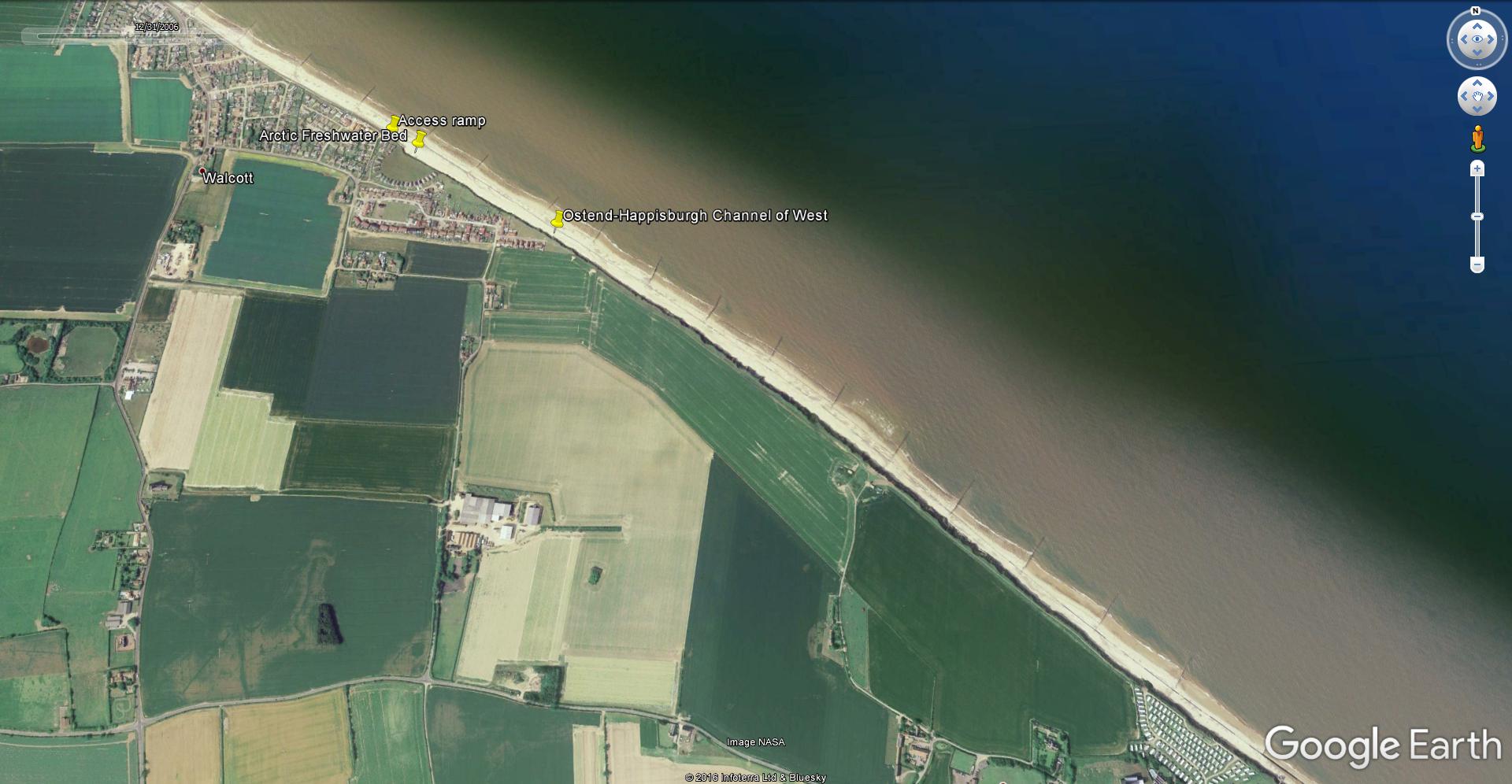
Geology
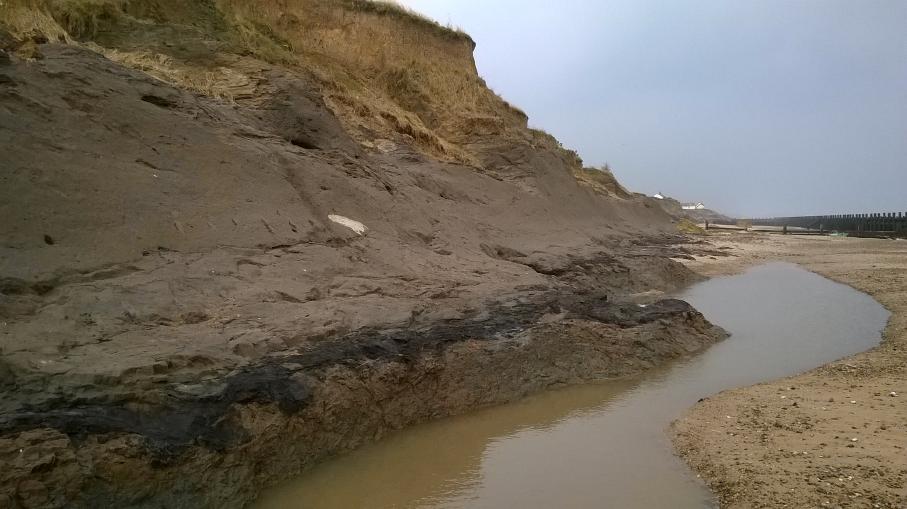
The low cliff here is substantially made of the Happisburgh Till in its lower half. It rests of Cromer Forest-bed deposits, which are exposed from time to time at the base of the cliff. The access ramp (Ostend Gap) is in the distance (above).
Summary of Ostend stratigraphy
| Bed | Description | Facies | Age | Climate |
| Walcott Till | Sandy, chalky till | Sub-glacial till | Anglian (MIS 12) | cold |
| Intermediate Beds | Laminated silt and clay, sand at the base | Turbidites in a lake | Anglian (MIS 12) | cold |
| Happisburgh Till | Glacial till | Sub-glacial | Anglian (MIS 12 | glacial |
| Arctic Fresh-water Bed (part of CF-b) | Organic sands and silt | Freshwater marsh | early Anglian (MIS 12) | cold |
| Cromer Forest-bed (Hill House Formation) | Organic clay and detritus mud, freshwater | River estuary at limit of tide | Pastonian (MIS 17 or MIS 19) | warm |
Glacial geology
Intermediate Beds
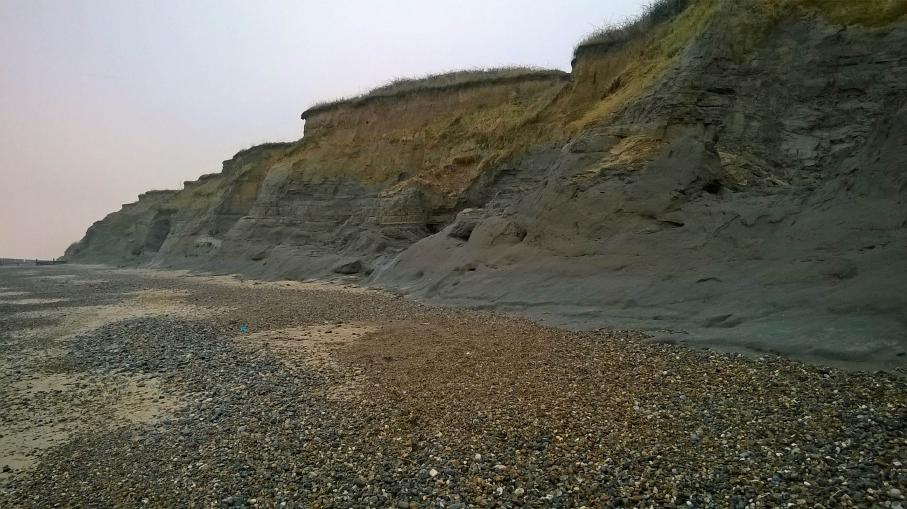
View of the cliffs 820m SE of access ramp datum (Latitude: 52°50'02.7" N Longitude: 1°31'10.6" E). The Happisburgh Till in the lower part of the cliff is succeeded by the Intermediate Beds. The lower unit of the Intermediate Beds in-fills hollows in the top of the till (fluted till surface or folding?) and is deformed (glaciotectonics or slumping?. Lunkka suggested that the deformation was due to intra-basinal slumping after rapid deposition. It is sandy with clay and silt partings. The second unit above consists of horizontal un-deformed clays and silts that are characteristic of turbidites.
Happisburgh Till
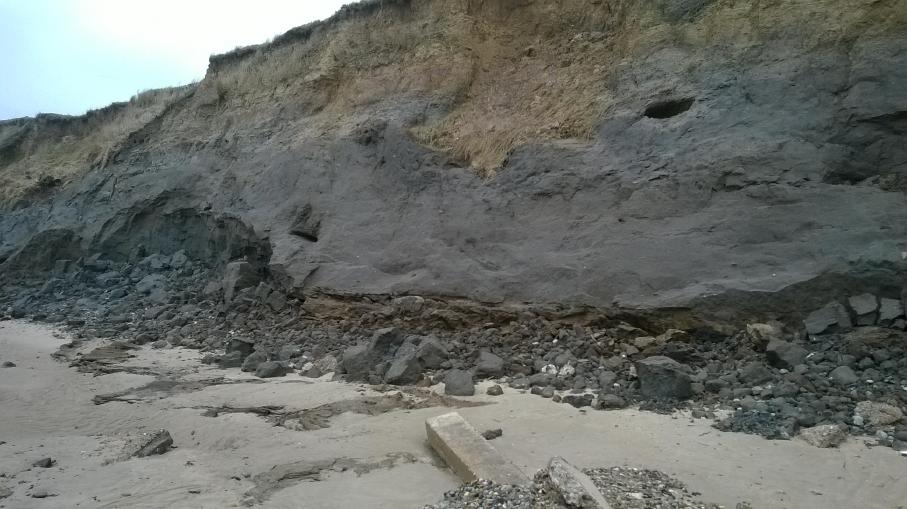
The Happisburgh Till (previously called the First Cromer Till) can be found occupying the lower part of the cliff along the entire length of the section between Ostend and Happisburgh. This is its type locality and it is easily observed. It is a tough, dark grey, homogeneous, sandy till with many small fragments of shell (cockle shells, Cerastoderma edule), flint, occasional chalk clasts and streaks, wood, and occasional pebbles and boulders of harder near- and far-travelled erratics including flint, sandstones, limestones, ironstones, lignite, igneous (granite, dolerite, ultramafic) and metamorphic (gneiss) rocks, that originate in outcrops on the eastern coast of northern England and the eastern parts of Scotland. Some of the erratic pebbles and boulders are faceted and striated, resulting from their travels within the Anglian ice-sheet. Despite long-standing assertions that this drift originated from Scandinavian ice, current thinking (promulgated by the British Geological Survey,l Royal Holloway College et al) indicates that the till contents originate from purely British outcrops and no demonstrably Scandinavian erratics have been discovered in situ in the Happisburgh Till.
Glacial erratic
An erratic (left and below) measuring 90 mm on its long axis, made of hard, dense greywacke (an immature sandstone rock found widely in the Southern Uplands of Scotland) was found in the Happisburgh Till (Latitude: 52°49'59.9" N, Longitude: 1°31'17.1" E). It displays facetting and striation from its travels in the Anglian ice-sheet, probably coming from the east coast somewhere north of Berwick upon Tweed around 400 km away from Happisburgh. It has a relatively smooth, rounded 'front' end and a 'plucked' and angular 'back' end. Its sides are faceted at various angles and the largest of these in area is the flattest and exhibits very clear striations and gouging.
Below the boulder in situ in the Happisburgh Till. Click on the images to see full-size image.
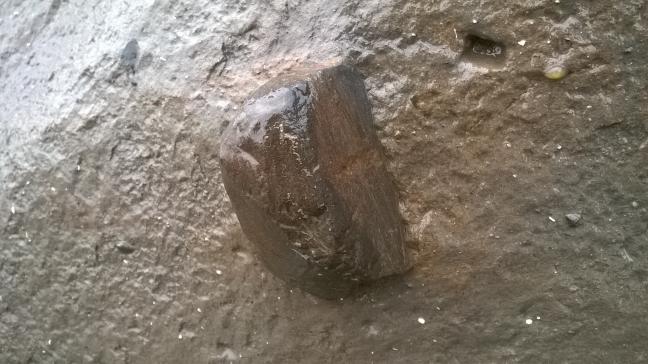 |
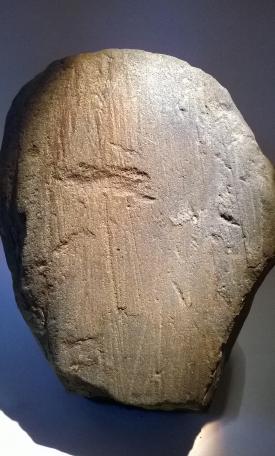 |
Cromer Forest-bed
Arctic Freshwater Bed
There are three outcrops of what have historically been called the Arctic Freshwater Bed (Beeston Regis, Mundesley and Ostend), although they may not all be of the same age. Clement Reid (1890), the pioneering Victorian geologist described them as arctic on the grounds of the dwarf willows and birch and the crushed remains of the European ground squirrel (European souslik) Spermophilus citellus. discovered immediately beneath the till. West (1980) apparently did not encounter them on his visits in the 1960s and 1970s. Parfitt et al (2010) rediscovered them close to the access ramp at Ostend in 2008 (52° 30' 17.8" N, 1° 30' 37.3" E) [there is a typographical error in the geo-reference in this paper] and referred them to the early Anglian stage. The succession they describe was as follows (top downwards):
Unit D is a dark grey (5Y 3/1), highly consolidated diamicton (Happisburgh Till) with matrix consisting of a massive clayey sand containing rare clasts, mostly flint. This forms the basal unit of the glacial succession at the site, recorded in detail by Hart (1999, Fig. 8.7).
Unit C consists of a brown (10YR 5/3) very fine sand up to 18 cm thick with indistinct horizontal laminations.
Unit B is a darker brown (10YR 4/3) weakly iron-cemented silty sand up to 42 cm thick, containing shells and occasional flint and quartzite pebbles. The lower contact is sharp and the sequences fines-upwards.
Unit A is a dark yellowish brown (10 YR 4/4) organic silt, at least 20 cm thick (not bottomed), containing organic detritus.
References
Lunkka, J.P. 1988. Sedimentation and deformation of the North Sea Drift Formation in the Happisburgh area, North Norfolk, in Croot, David G., Glaciotectonics: Forms and Processes, pp.109-122
Simon Parfitt, G. Russell Coope, Michael H. Field, Sylvia Peglar, Richard C. Preece and John E. Whittaker, 2010. Middle Pleistocene biota of the early Anglian 'Arctic Freshwater Bed' at Ostend, Norfolk, UK Proceedings of the Geologists' Association 121 (2010), pp. 55-65
Archaeology
The famous archaeology that is in the southern end of this section is covered on the Happisburgh page of this guide.
